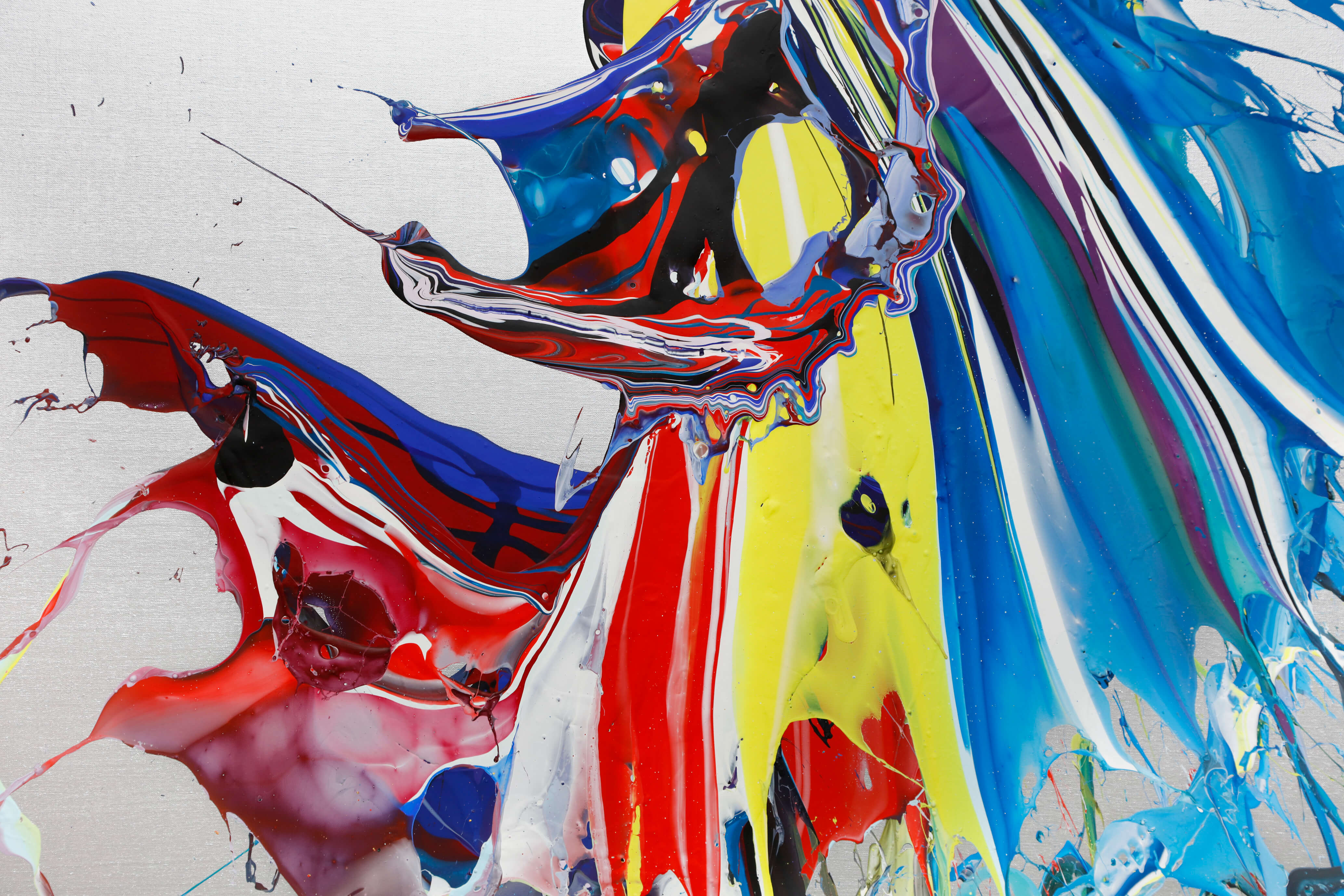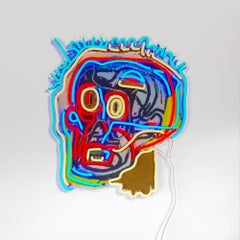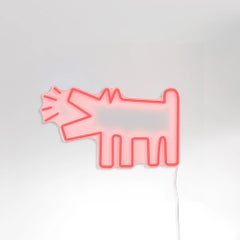Video Loading
Want more images or videos?
Request additional images or videos from the seller
1 of 8
Jean-Michel BASQUIAT - Banana YP x JM Basquiat Design Neon LED Lamp2025
2025
$515.09List Price
About the Item
- Creation Year:2025
- Dimensions:Height: 19.69 in (50 cm)Width: 16.15 in (41 cm)Depth: 1.58 in (4 cm)
- Medium:
- Movement & Style:
- After:Jean-Michel Basquiat (1960 - 1988, American)
- Period:
- Condition:
- Gallery Location:Madrid, ES
- Reference Number:1stDibs: LU1033117016142

About the Seller
5.0
Gold Seller
Premium sellers maintaining a 4.3+ rating and 24-hour response times
Established in 2011
1stDibs seller since 2018
183 sales on 1stDibs
Typical response time: 6 hours
Authenticity Guarantee
In the unlikely event there’s an issue with an item’s authenticity, contact us within 1 year for a full refund. DetailsMoney-Back Guarantee
If your item is not as described, is damaged in transit, or does not arrive, contact us within 7 days for a full refund. Details24-Hour Cancellation
You have a 24-hour grace period in which to reconsider your purchase, with no questions asked.Vetted Professional Sellers
Our world-class sellers must adhere to strict standards for service and quality, maintaining the integrity of our listings.Price-Match Guarantee
If you find that a seller listed the same item for a lower price elsewhere, we’ll match it.Trusted Global Delivery
Our best-in-class carrier network provides specialized shipping options worldwide, including custom delivery.You May Also Like
Hajime Sorayama Sexy Robot Floating Black Contemporary Art LED Light
Located in Draper, UT
Sexy Robot Floating (Black), 2020
PVC, plated resin, alloy, and LED light
22 × 14 × 14 in
55.9 × 35.6 × 35.6 cm
Edition of only 250.
Category
2010s Pop Art More Art
Materials
Metal
$5,000
H 22 in W 14 in D 14 in
SIMPLY QUEEN B - Original Mixed Media ArtWork.
By Mauro Oliveira
Located in LOS ANGELES, CA
**STORE CLOSURE - UP TO 80% OFF - TAKE ADVANTAGE OF IT**
***EVERYTHING MUST GO BY DECEMBER 31ST!***
***The artist is moving on to a new full time venture in 2026***
_______________________________________________________
This is the ultimate homage to QUEEN BE...
Category
21st Century and Contemporary Pop Art Mixed Media
Materials
Metal
$1,350 Sale Price
61% Off
H 41 in W 41 in D 2 in
Stop
By Peter Klasen
Located in Malmo, SE
Acrylic/neon/objects on iron.
Signed by the artist in the lower right.
Free shipment worldwide.
Acquired directly from the artist.
Artist Peter Klasen is a master of contrasts. Of...
Category
1990s Pop Art More Art
Materials
Iron
Yellowpop Neon Flowers lighted Wall Hanging/Sign - brand new in box
By Andy Warhol
Located in New York, NY
Yellowpop after Andy Warhol
Neon Flowers lighted Wall Hanging/Sign, 2022
Neon flex material, consisting of PVC or Silicon piping with LED lights mounted on a recycled acrylic board
Edition 258/500 (numbered on COA)
Box is plate signed; accompanied by official numbered COA authorized by the Warhol Foundation...
Category
2010s Pop Art Still-life Prints
Materials
Silicone, PVC, Acrylic Polymer, Neon Light, Mixed Media
Jam Master Jay, 2009
By TF Dutchman
Located in Jersey City, NJ
Tiffany style stained glass memorial work in honor of DJ Jam Master Jay
Handcrafted by TF Dutchman, "Jam Master Jay" is part of series of works that are odes to the four elements of hiphop, with Jam Master Jay representing the DJ. This piece is a one of a kind original Tiffany style stained glass panel. A detailed portrait painted with vitreous paint memorializes the legendary hip hop artist DJ Jam Master Jay of RUN-D.M.C.
Brilliant greens, yellows, blues and reds are enhanced by kiln fired, painted symbolic motifs including a turntable, JMJ's signature gold chain and the textured blue-gray drapery glass of JMJ's signature Adidas robe. TF Dutchman uses traditional original Tiffany window...
Category
Early 2000s Contemporary More Art
Materials
Metal, Copper
Scenic: Smog, Sunset
By Sharon Levy
Located in Boston, MA
Artist Commentary:
This is a translucent backlit painting, with LED lights behind it, that changes from daytime to sunset as you watch it. It describe...
Category
21st Century and Contemporary Impressionist Landscape Paintings
Materials
Metal
Aliens
By Alan Strack
Located in New York, NY
This unique art piece is made of the original 35mm film of the movie, framed in an oak wood frame and lit with lit with RGB color changing LED light that can be controlled and light changed with smartphone app CONTROLLER for iOS and Android system.
“I started by working with the idea of the large film...
Category
2010s Contemporary More Art
Materials
Oak, Film, LED Light
"Thin Skin" Contemporary Chinese Still Life Light Sculpture with Dancing Woman
Located in Houston, TX
Contemporary Chinese papercut of a still life of rocks and grass that is back lit with an LED video loop of a dancing female figure in red. There is a button at the bottom of the piece that can be pressed to activate the video. Once pressed, the woman begins to dance up from the lower right corner until she is fully standing and then she continues to dance back down until she is out of view.
About the Artist:
Liu Dao...
Category
Early 2000s Contemporary Mixed Media
Materials
Paper, LED Light, Mixed Media
$18,000
H 42 in W 42 in D 3 in
Synthesis B by Tom Price - Sculpture and lighting, LED, abstract
By Tom Price
Located in Paris, FR
Synthesis B is a sculpture by contemporary artist Tom Price. This sculpture is made of resin, tar, acrylic, steel, LED, dimensions are 200 × 8 × 9 cm (78.7 × 3.1 × 3.5 in). This artw...
Category
2010s Contemporary Abstract Sculptures
Materials
Steel
$13,972
H 78.75 in W 3.15 in D 3.55 in
Synthesis bench by Tom Price - light sculpture and bench
By Tom Price
Located in Paris, FR
Resin, tar, steel, acrylic, LED. 45 cm × 220 cm × 35 cm. Available on commission. Production delay: 8 months.
Synthesis Bench is one of Tom Price's 'hybrid' artworks sitting halfway ...
Category
2010s Contemporary Abstract Sculptures
Materials
Steel
$78,151
H 17.72 in W 86.62 in D 13.78 in
More From This Seller
View AllJean-Michel BASQUIAT - Untitled (Head) YP x JM Basquiat Design Neon LED Lamp
By Jean-Michel Basquiat
Located in Madrid, Madrid
Untitled (Head) YP x JM Basquiat
Date of creation: 2024
Medium: PVC or Silicon piping with LED lights mounted on recycled acrylic board
Edition: Open
Size: 50 x 58 cm
Condition: Bra...
Category
2010s Pop Art More Art
Materials
LED Light, Neon Light
Jean-Michel BASQUIAT - The Crown YP x JM Basquiat Design Neon LED Lamp
By Jean-Michel Basquiat
Located in Madrid, Madrid
The Crown YP x JM Basquiat
Date of creation: 2024
Medium: PVC or Silicon piping with LED lights mounted on recycled acrylic board
Edition: Open
Size: 40 x 30 cm
Condition: Brand new...
Category
2010s Pop Art More Art
Materials
LED Light, Neon Light
Jean-Michel BASQUIAT - PEZ Dispenser YP x JM Basquiat Design Neon LED Lamp
By Jean-Michel Basquiat
Located in Madrid, Madrid
PEZ Dispenser YP x JM Basquiat
Date of creation: 2024
Medium: PVC or Silicon piping with LED lights mounted on recycled acrylic board
Edition: Open
Size: 40 x 50 cm
Condition: Brand...
Category
2010s Pop Art More Art
Materials
LED Light, Neon Light
KEITH HARING - Barking Dog YP x Keith Haring Design Neon LED Lamp. Pop Art
By (after) Keith Haring
Located in Madrid, Madrid
Barking Dog YP x Keith Haring
Date of creation: 2024
Medium: PVC or Silicon piping with LED lights mounted on recycled acrylic board
Edition: Open
Size: 50 x 30 cm
Condition: Brand ...
Category
2010s Pop Art More Art
Materials
LED Light, Neon Light
ANDY WARHOL - Banana YP x Andy Warhol. Design Neon LED Lamp. Pop Art, Wall
By Andy Warhol
Located in Madrid, Madrid
Banana YP x Andy Warhol
Date of creation: 2024
Medium: PVC or Silicon piping with LED lights mounted on recycled acrylic board
Edition: Open
Size: 62 x 26.5 cm
Condition: Brand new
...
Category
2010s Pop Art More Art
Materials
LED Light, Neon Light
KEITH HARING - Triple Eyes YP x Keith Haring Design Neon Lamp. Pop Art Urban
By Keith Haring
Located in Madrid, Madrid
Triple Eyes YP x Keith Haring
Date of creation: 2025
Medium: PVC or Silicon piping with LED lights mounted on recycled acrylic board
Edition: Open
Size: 51 x 52 cm
Condition: Brand ...
Category
2010s Pop Art More Art
Materials
LED Light, Neon Light



